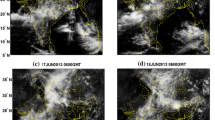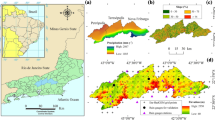Abstract
The present study investigates the climatological rainfall vulnerability districts associated with monsoon depressions (MDs) over Odisha using both observational and modeling perspectives for a period of 34 years (1980–2013). Four heavy rainfall cases associated with MDs crossed Odisha are simulated with the help of high-resolution advanced research weather research forecasting system, and the rainfall vulnerability mapping for more than 1-mm rainfall values at district level are evaluated. The observational analyses on the frequency of MDs for the study period exhibit a decreasing trend. It is noticed that the rainfall vulnerability districts are present to the left side of the track of the MDs. The model simulation result depicts that the location of formation of MDs is always behind the actual position of the system and also do the landfall after the actual time. The model has a positive bias in the prediction of the intensity of rainfall and a spatial shift in the distribution of rainfall. The model is showing higher Heidke skill for less intensity rainfall threshold values. The analysis also suggests that the maximum rainfall vulnerable districts are present 150–200 km away from the original position, still these districts are present to the left side of the MDs. Analysis on the horizontal and vertical structure of MD suggests that the presence of relative humidity is less in WRF and the distribution of relative vorticity is not same as the observation, which may be the major causes of having such error in predicting heavy rainfall.
















Similar content being viewed by others
References
Bahinipati CS (2014) Assessment of vulnerability to cyclones and floods in Odisha, India: a district-level analysis. Curr Sci 107(12):1997–2007
Cohen NY, Boos WR (2014) Has the number of Indian summer monsoon depressions decreased over the last 30 years? Geophys Res Lett 41:7846–7853. https://doi.org/10.1002/2014GL061895
Daggupaty SM, Sikka DR (1977) On the vorticity budget and vertical velocity distribution associated with the life cycle of a monsoon depression. J Atmos Sci 34(5):773–792
Dee DP, Uppala SM, Simmons AJ, Berrisford P, Poli P, Kobayashi S, Andrae U, Balmaseda MA, Balsamo G, Bauer P, Bechtold P, Beljaars ACM, van de Berg L, Bidlot J, Bormann N, Delsol C, Dragani R, Fuentes M, Geer AJ, Haimberger L, Healy SB, Hersbach H, Hólm EV, Isaksen L, Kållberg P, Köhler M, Matricardi M, McNally AP, Monge-Sanz BM, Morcrette J-J, Park B-K, Peubey C, de Rosnay P, Tavolato C, Thépaut J-N, Vitart F (2011) The ERA-interim reanalysis: configuration and performance of the data assimilation system. Q J R Meteorol Soc 137:553–597. https://doi.org/10.1002/qj.828
Deressa T, Hassan RM, Ringler C (2008) Measuring Ethiopian farmers’ vulnerability to climate change across regional states. IFPRI Discussion Paper 00806. International Food Policy Research Institute, Washington DC
Desai BN (1972) Distribution of heavy rains in summer monsoon depressions moving west to northwest across India from the north Bay of Bengal. VayuMandal 2:105–106
Dudhia J (1993) Anonhydrostatic version of Penn State—NCAR mesoscale model: validation tests and simulation of an Atlantic cyclone and cold front. Mon Weather Rev 121:1493–1513
Hong SY, Dudhia J, Chen SH (2004) A revised approach to ice microphysics process for the bulk parameterization of clouds and precipitation. Mon Weather Rev 132:103–120
Hong SY, Noh Y, Dudhia J (2006) A new vertical diffusion package with an explicit treatment of entrainment processes. Mon Weather Rev 134:2318–2341
Kain JS, Fritsch JM (1993) Convective parameterization for mesoscale models: the Kain–Fritsch scheme. In: McFarquhar G (ed) The representation of cumulus convection in numerical models. Meteorological Monographs, American Meteorological Society, pp 165–170
Kanamitsu M (1989) Description of the NMC global data assimilation and forecast system. Weather Forecast 4:335–342
Krishnamurthy V, Ajayamohan RS (2010) Composite structure of monsoon low pressure systems and its relation to Indian rainfall. J Clim 23:4285–4305
Krishnamurti TN, Kanamitsu M, Godbole R, Chang CB, Carrnd F, Chow JH (1975) Study of monsoon depression (I) synoptic structure. J Meteorol Soc Jpn 53:227–239
Krishnamurti TN, Kanamitsu M, Godbole R, Chang CB, Carrnd F, Chow JH (1976) Study of monsoon depression (II), dynamical structure. J Meteorol Soc Jpn Ser II 54(4):208–225
Mitra AK, Das Gupta M, Singh SV, Krishnamurti TN (2003) Daily rainfall for the Indian monsoon region from merged satellite and rain gauge values: large-scale analysis from real-time data. J Hydrometeorol 4(5):769–781
Mohanty UC, Osuri Krishna K, Routray A, Mohapatra M, Sujata P (2010) Simulation of Bay of Bengal tropical cyclones with WRF model: impact of initial and boundary conditions. Mar Geodesy 33(4):294–314
Mohanty UC, Routray A, Osuri KK, Kiran Prasad S (2012) A study on simulation of heavy rainfall events over Indian region with ARW-3DVAR modeling system. Pure Appl Geophys 169(3):381–399
Mohapatra M, Mohanty UC (2004) Some characteristics of low pressure systems and summer monsoon rainfall over Orissa. Curr Sci 87:9
Mooley DA (1973) Some aspects of Indian monsoon depressions and associated rainfall. Mon Weather Rev 101:271–280
Nadimpalli R, Osuri KK, Pattanayak S, Mohanty UC, Nageswararao MM, Prasad SK (2016) Real-time prediction of movement, intensity and storm surge of very severe cyclonic storm Hudhud over Bay of Bengal using high-resolution dynamical model. Nat Hazards 81(3):1771–1795
O’Brien KL et al (2004) Mapping vulnerability to multiple stressors: climate change and globalisation in India. Glob Environ Change 14(4):303–313
Osuri KK, Mohanty UC, Routray A, Kulkarni MA, Mohapatra M (2012) Sensitivity of physical parameterization schemes of WRF model for the simulation of Indian seas tropical cyclones. Nat Hazards 63:1337–1359. https://doi.org/10.1007/s11069-011-9862-0
Pai DS, Sridhar L, Rajeevan M, Sreejith OP, Satbhai NS, Mukhopadhyay B (2014) Development of a new high spatial resolution (0.25° × 0.25°) long period (1901–2010) daily gridded rainfall dataset over India and its comparison with existing datasets over the region. Mausam 65(1):1–18
Pattanaik DR, Mukhopadhyay B, Kumar A (2012) Monthly forecast of Indian Southwest monsoon rainfall based on NCEP’s coupled forecast system. Atmos Clim Sci 2:479–491
Potty KVJ, Mohanty UC, Raman S (2000) Numerical simulation of monsoon depressions over India with a high resolution nested regional model. Meteorol Appl 7(1):45–60
Prajeesh AG, Ashok K, Bhaskar Rao DV (2013) Falling monsoon depression frequency: a Gray-Sikka conditions perspective. Sci Rep. https://doi.org/10.1038/srep02989
Rajeevan M, De US, Prasad RK (2000) Decadal variation of sea surface temperatures, cloudiness and monsoon depressions in the north Indian Ocean. Curr Sci 79:283–285
Rao YP (1976) Southwest monsoon: meteorological monograph synoptic meteorology. India Meteorological Department (IMD), p 107
Routray A, Mohanty UC, Osuri KK, Kar SC, Niyogi D (2015) Impact of satellite radiance data on simulations of Bay of Bengal tropical cyclones using the WRF-3DVAR modeling system. IEEE Trans Geosci Remote Sens. https://doi.org/10.1109/tgrs.2015.2498971
Sabre M, Hodges K, Laval K, Polcher J, Desalmand F (2000) Simulation of monsoon disturbances in the LMD GCM. Mon Weather Rev 128(11):3752–3771
Sikka DR (1977) Some aspects of the life history, structure and movement of monsoon depressions. Pure Appl Geophys 115:1501–1529
Skamaraock WC, Klemp JB, Dudhia J, Gill DO, Barker DM, Wang W, Powers JG (2005) A description of the advanced research WRF version 2, NCAR technical note
Srinivasan V, Raman S, Mukherji S (1972) South-west monsoon: typical situations over west Bengal and Assam and adjacent states, I. Met. D.FMU Report III-3.6
Swain M, Pattanayak S, Mohanty UC (2018) Characteristics of occurrence of heavy rainfall events over Odisha during summer monsoon season. Dyn Atmos Oceans 82:107–118
Acknowledgements
The authors acknowledge the financial support given by the Department of Agriculture and Farmer Welfare (DA&FW), Government of India, to carry out the present research work. The authors acknowledge IMD and ERA-Interim for providing valuable datasets to validate the model-simulated results. The authors especially thank NCEP for providing FNL analysis datasets.
Author information
Authors and Affiliations
Corresponding author
Additional information
Publisher's Note
Springer Nature remains neutral with regard to jurisdictional claims in published maps and institutional affiliations.
Rights and permissions
About this article
Cite this article
Swain, M., Pattanayak, S., Mohanty, U.C. et al. Prediction of extreme rainfall associated with monsoon depressions over Odisha: an assessment of coastal zone vulnerability at district level. Nat Hazards 102, 607–632 (2020). https://doi.org/10.1007/s11069-019-03633-0
Received:
Accepted:
Published:
Issue Date:
DOI: https://doi.org/10.1007/s11069-019-03633-0




